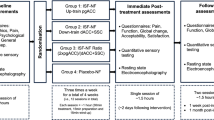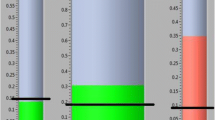Abstract
Chronic pain, usually refractory to analgesics, is a significant problem for many individuals with spinal cord injury (SCI). Preliminary studies suggest that electroencephalography (EEG) biofeedback (also known as neurofeedback, NF) has the potential to help patients with otherwise refractory chronic pain. However, there remain many unanswered questions about the effects and mechanisms of this treatment. We studied 13 individuals with SCI and chronic pain with NF. Ten of the 13 individuals completed 4 sessions each of three different neurofeedback protocols assigned in random order for a total of 12 NF sessions. All three protocols had similar immediate effects on pain intensity. In addition, the participants reported modest pre- to post-treatment decreases in worst pain and pain unpleasantness following completion of the 12 NF sessions. These improvements were maintained at 3-month follow-up. The majority of the participants felt they benefited from and were satisfied with the treatment. No significant effects on measures of other outcome domains (sleep quality, pain interference and fatigue) were observed, although there was a non-significant trend for an increase in fatigue. Finally, pre- to post-treatment changes in EEG bandwidth activity, consistent with the training protocols, were observed in θ and α but not β frequencies. The findings provide preliminary support for the potential efficacy of NF for the treatment of SCI-related pain, and suggest that further clinical studies are warranted.
Similar content being viewed by others
References
Amtmann, D., Cook, K. F., Jensen, M. P., Chen, W. H., Choi, S., Revicki, D., et al. (2010). Development of a PROMIS item bank to measure pain interference. Pain, 150(1), 173–182. doi:10.1016/j.pain.2010.04.025.
Bakhshayesh, A. R., Hansch, S., Wyschkon, A., Rezai, M. J., & Esser, G. (2011). Neurofeedback in ADHD: A single-blind randomized controlled trial. European Child and Adolescent Psychiatry, 20(9), 481–491. doi:10.1007/s00787-011-0208-y.
Bazanova, O. M., & Aftanas, L. I. (2010). Individual EEG α activity analysis for enhancemnet neurofeedback efficiency: Two case studies. Journal of Neurotherapy, 14(3), 244–253. doi:10.1080/10874208.2010.501517.
Boord, P., Siddall, P. J., Tran, Y., Herbert, D., Middleton, J., & Craig, A. (2008). Electroencephalographic slowing and reduced reactivity in neuropathic pain following spinal cord injury. Spinal Cord, 46(2), 118–123. doi:10.1038/sj.sc.3102077.
Bromm, B., Ganzel, R., Herrmann, W. M., Meier, W., & Scharein, E. (1986a). Pentazocine and flupirtine effects on spontaneous and evoked EEG activity. Neuropsychobiology, 16(2–3), 152–156. doi:10.1159/000118317.
Bromm, B., & Lorenz, J. (1998). Neurophysiological evaluation of pain. Electroencephalography and Clinical Neurophysiology, 107(4), 227–253. doi:10.1016/S0013-4694(98)00075-3.
Bromm, B., Meier, W., & Scharein, E. (1986b). Imipramine reduces experimental pain. Pain, 25(2), 245–257. doi:10.1016/0304-3959(86)90100-4.
Cardenas, D. D., Turner, J. A., Warms, C. A., & Marshall, H. M. (2002). Classification of chronic pain associated with spinal cord injuries. Archives of Physical Medicine and Rehabilitation, 83(12), 1708–1714. doi:10.1053/apmr.2002.35651.
Caro, X. J., & Winter, E. F. (2011). EEG biofeedback treatment improves certain attention and somatic symptoms in fibromyalgia: A pilot study. Appl Psychophysiol Biofeedback, 36(3), 193–200. doi:10.1007/s10484-011-9159-9.
Chen, A. C. (1993). Human brain measures of clinical pain: A review II. Tomographic imagings. Pain, 54(2), 133–144. doi:10.1016/0304-3959(93)90201-Y.
Chen, A. C. (2001). New perspectives in EEG/MEG brain mapping and PET/fMRI neuroimaging of human pain. International Journal of Psychophysiology, 42(2), 147–159. doi:10.1016.
Cook, K. F., Molton, I. R., & Jensen, M. P. (2011). Fatigue and aging with a disability. Archives of Physical Medicine and Rehabilitation, 92(7), 1126–1133. doi:10.1016/j.apmr.2011.02.017.
Egner, T., & Gruzelier, J. H. (2004). EEG biofeedback of low β band components: Frequency-specific effects on variables of attention and event-related brain potentials. Clinical Neurophysiology, 115(1), 131–139. doi:10.1016/S1388-2457(03)00353-5.
Egner, T., Strawson, E., & Gruzelier, J. H. (2002). EEG signature and phenomenology of α/θ neurofeedback training versus mock feedback. Appl Psychophysiol Biofeedback, 27(4), 261–270.
Ehde, D. M., Jensen, M. P., Engel, J. M., Turner, J. A., Hoffman, A. J., & Cardenas, D. D. (2003). Chronic pain secondary to disability: A review. Clinical Journal of Pain, 19(1), 3–17. doi:10.1097/00002508-200301000-00002.
Finnerup, N. B., Johannesen, I. L., & Sindrup, S. H. (2001). Pain and dysesthesia in patients with spinal cord injury: A postal survey. Spinal Cord, 39, 256–262.
Gannon, L., & Sternbach, R. A. (1971). α enhancement as a treatment for pain: A case study. Journal of Behavioural Therapy and Experimental Psychiatry, 2, 209–213. doi:10.1016/0005-7916(71)90061-9.
Gevensleben, H., Holl, B., Albrecht, B., Schlamp, D., Kratz, O., Studer, P., et al. (2009a). Distinct EEG effects related to neurofeedback training in children with ADHD: A randomized controlled trial. International Journal of Psychophysiology, 74(2), 149–157. doi:10.1016/j.ijpsycho.2009.08.005.
Gevensleben, H., Holl, B., Albrecht, B., Vogel, C., Schlamp, D., Kratz, O., et al. (2009b). Is neurofeedback an efficacious treatment for ADHD? A randomised controlled clinical trial. Journal of Child Psychology and Psychiatry, 50(7), 780–789. doi:10.1111/j.1469-7610.2008.02033.x.
Hammond, D. C. (2010). The need for individualization in neurofeedback: Heterogeneity in QEEG patterns associated with diagnoses and symptoms. Appl Psychophysiol Biofeedback, 35(1), 31–36. doi:10.1007/s10484-009-9106-1.
Hays, R. D., & Stewart, A. L. (1992). Sleep measures. In A. L. Stewart & J. E. Ware (Eds.), Measuring functioning and well-being: The medical outcomes study approach (pp. 235–259). Durham, NC: Duke University Press.
Huber, M. T., Bartling, J., Pachur, D., Woikowsky-Biedau, S., & Lautenbacher, S. (2006). EEG responses to tonic heat pain. Experimental Brain Research, 173(1), 14–24. doi:10.1007/s00221-006-0366-1.
Jasper, H. H. (1958). The ten-twenty electrode system of the international federation. Electroencephalography and Clinical Neurophysiology, 10, 371–375.
Jensen, M., Grierson, C., Tracy-Smith, V., Bacigalupi, S. C., & Othermer, S. (2007a). Neurofeedback treatment for pain associated with complex regional pain syndrome type I: A case series. Journal of Neurotherapy, 11, 45–53. doi:10.1300/J184v11n01_04.
Jensen, M. P., Hakimian, S., Sherlin, L. H., & Fregni, F. (2008). New insights into neuromodulatory approaches for the treatment of pain. Journal of Pain, 9(3), 193–199. doi:10.1016/j.jpain.2007.11.003.
Jensen, M. P., Hoffman, A. J., & Cardenas, D. D. (2005). Chronic pain in individuals with spinal cord injury: A survey and longitudinal study. Spinal Cord, 43(12), 704–712. doi:10.1038/sj.sc.3101777.
Jensen, M. P., Kuehn, C. M., Amtmann, D., & Cardenas, D. D. (2007b). Symptom burden in persons with spinal cord injury. Archives of Physical Medicine and Rehabilitation, 88(5), 638–645. doi:10.1016/j.apmr.2007.02.002.
Jensen, M. P., Sherlin, L. H., Gertz, K. J., Braden, A. L., Kupper, A. E., Gianas, A., et al. (2013). Brain EEG activity correlates of chronic pain in persons with spinal cord injury: Clinical implications. Spinal Cord, 51(1), 55–58. doi:10.1038/sc.2012.84.
Kayiran, S., Dursun, E., Dursun, N., Ermutlu, N., & Karamursel, S. (2010). Neurofeedback intervention in fibromyalgia syndrome; a randomized, controlled, rater blind clinical trial. Appl Psychophysiol Biofeedback, 35(4), 293–302. doi:10.1007/s10484-010-9135-9.
Krupp, L. B., LaRocca, N. G., Muir-Nash, J., & Steinberg, A. D. (1989). The fatigue severity scale. Application to patients with multiple sclerosis and systemic lupus erythematosus. Archives of Neurology, 46(10), 1121–1123. doi:10.1001/archneur.1989.00520460115022.
Llinas, R., Urbano, F. J., Leznik, E., Ramirez, R. R., & van Marle, H. J. (2005). Rhythmic and dysrhythmic thalamocortical dynamics: GABA systems and the edge effect. Trends in Neurosciences, 28(6), 325–333. doi:10.1016/j.tins.2005.04.006.
Raymond, J., Varney, C., Parkinson, L. A., & Gruzelier, J. H. (2005). The effects of α/θ neurofeedback on personality and mood. Brain research. Cognitive Brain Research, 23(2–3), 287–292. doi:10.1016/j.cogbrainres.2004.10.023.
Ros, T., Moseley, M. J., Bloom, P. A., Benjamin, L., Parkinson, L. A., & Gruzelier, J. H. (2009). Optimizing microsurgical skills with EEG neurofeedback. BMC Neurosci, 10, 87. doi:10.1186/1471-2202-10-87.
Sarnthein, J., Stern, J., Aufenberg, C., Rousson, V., & Jeanmonod, D. (2006). Increased EEG power and slowed dominant frequency in patients with neurogenic pain. Brain, 129(Pt 1), 55–64. doi:10.1093/brain/awh631.
Seifert, F., Fuchs, O., Nickel, F. T., Garcia, M., Dorfler, A., Schaller, G., et al. (2010). A functional magnetic resonance imaging navigated repetitive transcranial magnetic stimulation study of the posterior parietal cortex in normal pain and hyperalgesia. Neuroscience, 170(2), 670–677. doi:10.1016/j.neuroscience.2010.07.024.
Sherlin, L., & Congedo, M. (2005). Obsessive-compulsive dimension localized using low-resolution brain electromagnetic tomography (LORETA). Neuroscience Letters, 387(2), 72–74. doi:10.1016/j.neulet.2005.06.069.
Sime, A. (2004). Case study of trigeminal neuralgia using neurofeedback and peripheral biofeedback. Journal of Neurotherapy, 8, 59–71. doi:10.1300/J184v08n01_05.
Stokes, D. A., & Lappin, M. S. (2010). Neurofeedback and biofeedback with 37 migraineurs: A clinical outcome study. Behavioral and Brain Functions, 6, 9. doi:10.1186/1744-9081-6-9.
Turk, D. C., Dworkin, R. H., Allen, R. R., Bellamy, N., Brandenburg, N., Carr, D. B., et al. (2003). Core outcome domains for chronic pain clinical trials: IMMPACT recommendations. Pain, 106(3), 337–345. doi:10.1016/j.pain.2003.08.001.
Turner, J. A., Cardenas, D. D., Warms, C. A., & McClellan, C. B. (2001). Chronic pain associated with spinal cord injuries: A community survey. Archives of Physical Medicine and Rehabilitation, 82(4), 501–509. doi:10.1053/apmr.2001.21855.
Warms, C. A., Turner, J. A., Marshall, H. M., & Cardenas, D. D. (2002). Treatments for chronic pain associated with spinal cord injuries: Many are tried, few are helpful. Clinical Journal of Pain, 18(3), 154–163. doi:10.1097/00002508-200205000-00004.
Acknowledgments
This research was supported by a research grant from the Craig H. Neilsen foundation.
Author information
Authors and Affiliations
Corresponding author
Rights and permissions
About this article
Cite this article
Jensen, M.P., Gertz, K.J., Kupper, A.E. et al. Steps Toward Developing an EEG Biofeedback Treatment for Chronic Pain. Appl Psychophysiol Biofeedback 38, 101–108 (2013). https://doi.org/10.1007/s10484-013-9214-9
Published:
Issue Date:
DOI: https://doi.org/10.1007/s10484-013-9214-9




